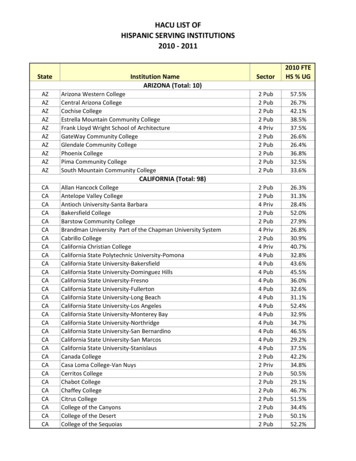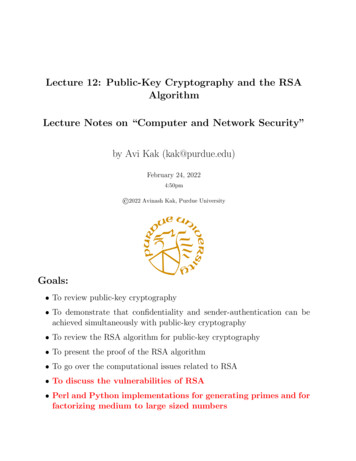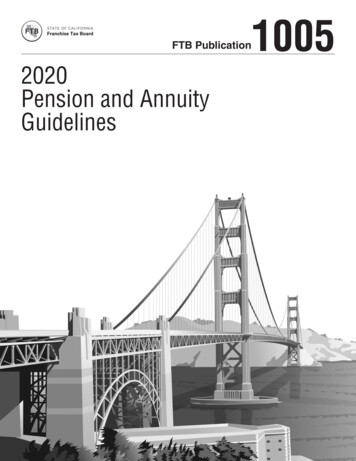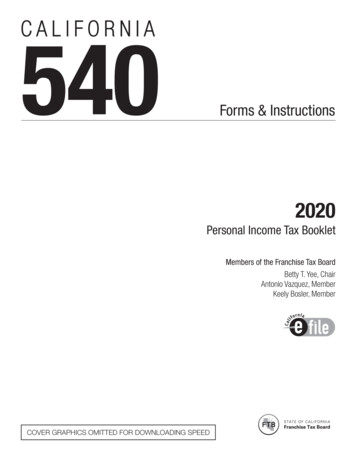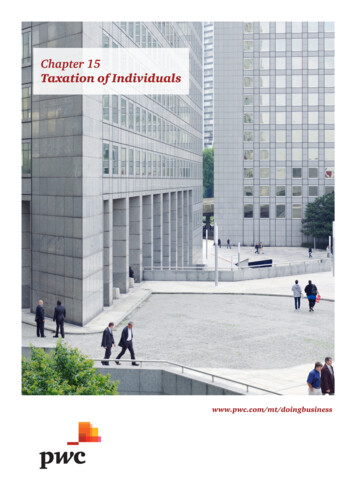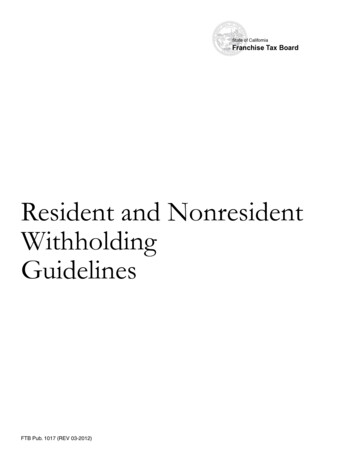
Transcription
State of CaliforniaFranchise Tax BoardResident and NonresidentWithholdingGuidelinesFTB Pub. 1017 (REV 03-2012)
For additional information, contact Withholding Services and ComplianceTelephone:888.792.4900916.845.4900Our automated telephone system allows you to access important information seven days a week, 24 hours a day. If thesystem does not completely answer your questions, you may speak with a representative 8 a.m. to 5 p.m. weekdays,except state holidays.To get forms, publications, and other withholding information, go to our website or email us:Website:Email ial email)Fax:916.845.9512Mailing Address:WITHHOLDING SERVICES AND COMPLIANCE MS F182FRANCHISE TAX BOARDPO BOX 942867SACRAMENTO CA 94267-0651Express Mail/Overnight Withholding Services and Compliance MS F182Delivery:Franchise Tax BoardSacramento CA 95827Get FTB 1131, Franchise Tax Board Privacy Notice, at ftb.ca.gov and search for privacy notice, or call us at800.338.0505. If outside the United States, call 916.845.6500.Internet and Telephone Assistance/Asistencia Por Internet y TeléfonoWebsite/Sitio web: ftb.ca.govTelephone/Teléfono: 800.852.5711 from within the United States/Dentro de los Estados Unidos916.845.6500 from outside the United States/Fuera de los Estados UnidosTTY/TDD:800.822.6268 for persons with hearing or speech impairments/Personas con discapacidadesauditivas y del hablaPAGE FTB Pub. 1017 (REV 03-2012)
Table of ContentsPAGEPurpose . . . . . . . . . . . . . . . . . . . . . . . . . . . . . . . . . . . . . . . . . . . . . . . . . . . . . . . . . . . . . . . . . . . . . . . . . . . . . . . . . . . . . . . 4Law References . . . . . . . . . . . . . . . . . . . . . . . . . . . . . . . . . . . . . . . . . . . . . . . . . . . . . . . . . . . . . . . . . . . . . . . . . . . . . . . . . 4What’s New . . . . . . . . . . . . . . . . . . . . . . . . . . . . . . . . . . . . . . . . . . . . . . . . . . . . . . . . . . . . . . . . . . . . . . . . . . . . . . . . . . . . . 4Frequently Asked Questions . . . . . . . . . . . . . . . . . . . . . . . . . . . . . . . . . . . . . . . . . . . . . . . . . . . . . . . . . . . . . . . . . . . . . . . 4General Withholding Requirements . . . . . . . . . . . . . . . . . . . . . . . . . . . . . . . . . . . . . . . . . . . . . . . . . . . . . . . . . . . . . . . . . 4Income Subject to Withholding . . . . . . . . . . . . . . . . . . . . . . . . . . . . . . . . . . . . . . . . . . . . . . . . . . . . . . . . . . . . . . . . . . . . 6Entities Subject to Withholding . . . . . . . . . . . . . . . . . . . . . . . . . . . . . . . . . . . . . . . . . . . . . . . . . . . . . . . . . . . . . . . . . . . . 6Withholding Exemptions . . . . . . . . . . . . . . . . . . . . . . . . . . . . . . . . . . . . . . . . . . . . . . . . . . . . . . . . . . . . . . . . . . . . . . . . . 7Income Allocation . . . . . . . . . . . . . . . . . . . . . . . . . . . . . . . . . . . . . . . . . . . . . . . . . . . . . . . . . . . . . . . . . . . . . . . . . . . . . . . 9Reduced Withholding and Waivers of Withholding . . . . . . . . . . . . . . . . . . . . . . . . . . . . . . . . . . . . . . . . . . . . . . . . . . . . 10Reduced Withholding . . . . . . . . . . . . . . . . . . . . . . . . . . . . . . . . . . . . . . . . . . . . . . . . . . . . . . . . . . . . . . . . . . . . . . . 10Waivers of Withholding . . . . . . . . . . . . . . . . . . . . . . . . . . . . . . . . . . . . . . . . . . . . . . . . . . . . . . . . . . . . . . . . . . . . . . 11Nonwage, Independent Contractors, Rents and Royalties, Beneficiaries of Estates and Trusts . . . . . . . . . . . . . . . . 12Entertainment . . . . . . . . . . . . . . . . . . . . . . . . . . . . . . . . . . . . . . . . . . . . . . . . . . . . . . . . . . . . . . . . . . . . . . . . . . . . . . . . . . 14Domestic Pass-Through Entities . . . . . . . . . . . . . . . . . . . . . . . . . . . . . . . . . . . . . . . . . . . . . . . . . . . . . . . . . . . . . . . . . . . 14Foreign (Non-U.S.) Partners . . . . . . . . . . . . . . . . . . . . . . . . . . . . . . . . . . . . . . . . . . . . . . . . . . . . . . . . . . . . . . . . . . . . . . . 17Reporting and Remitting Withholding Amounts/Due Dates . . . . . . . . . . . . . . . . . . . . . . . . . . . . . . . . . . . . . . . . . . . . . 17Domestic (Nonforeign) . . . . . . . . . . . . . . . . . . . . . . . . . . . . . . . . . . . . . . . . . . . . . . . . . . . . . . . . . . . . . . . . . . . . . . 18Foreign (Non-U.S.) Partners . . . . . . . . . . . . . . . . . . . . . . . . . . . . . . . . . . . . . . . . . . . . . . . . . . . . . . . . . . . . . . . . . . 19Withholding Agent Liability and Penalties . . . . . . . . . . . . . . . . . . . . . . . . . . . . . . . . . . . . . . . . . . . . . . . . . . . . . . . . . . . 19Requirement to File a California Tax Return . . . . . . . . . . . . . . . . . . . . . . . . . . . . . . . . . . . . . . . . . . . . . . . . . . . . . . . . . . 20Where to Get Forms and More Information . . . . . . . . . . . . . . . . . . . . . . . . . . . . . . . . . . . . . . . . . . . . . . . . . . . . . . . . . . 21Index . . . . . . . . . . . . . . . . . . . . . . . . . . . . . . . . . . . . . . . . . . . . . . . . . . . . . . . . . . . . . . . . . . . . . . . . . . . . . . . . . . . . . . . . . . 22FTB Pub. 1017 (REV 03-2012) PAGE
Resident and Nonresident Withholding GuidelinesFTB Publication 1017Purposepartners. R&TC Section 18666 generally conforms tofederal IRC Section 1446 to the extent that the income isfrom California sources.This publication provides guidance on withholdingrequirements to assist you to: Withhold on payments to nonresident independentcontractors, including entertainers. Withhold on rent or royalty payments to nonresidents. Withhold on distributions to nonresident beneficiaries. Meet domestic and foreign nonresident partnerwithholding requirements.For information on real estate withholding, refer to theFranchise Tax Board (FTB) Publication 1016, Real EstateWithholding Guidelines.For information on employee wage withholding,contact the California Employment DevelopmentDepartment (EDD) at edd.ca.gov.For withholding purposes, both LLCs, classified aspartnerships, and LLPs are treated like partnerships.For purposes of this publication, LLCs and LLPsare generally included in the term “partnership” andmembers are generally included in the term “partner.”LLC and LLP information returns are included in the term“partnership information returns.” FTB Form 568, LimitedLiability Company Return of Income, is included inFTB Form 565, Partnership Return of Income. However,LLCs should specifically see questions 29 and 30 relatingto consenting and nonconsenting members.Law ReferencesWhat’s NewGeneralCalifornia Revenue and Taxation Code (R&TC)Section 18662 and the related regulations requirewithholding of California income or franchise taxes frompayments and distributions made to nonresidents onCalifornia source income.With certain limited exceptions, R&TC Section 18664applies backup withholding to reportable payments madeon or after January 1, 2010.R&TC Section 18664 applies backup withholding(Section 3406 of the Internal Revenue Code (IRC)) toreportable payments made on or after January 1, 2010.R&TC Section 18668 makes the withholding agent liableto remit the tax withholding required.R&TC Section 17951 contains the provision requiringnonresidents to be taxed on all income from Californiasources. California source income includes paymentsfor personal services performed in California. Where thenonresident lives, the location where the contract forservices is entered into, or the place of payment does notdetermine the source of income from personal services.The location where the personal services are performeddetermines the source of income. Nonresidents mustinclude in California gross income the gross payments forall services performed in California.Domestic (Nonforeign) S CorporationShareholders and PartnersR&TC Section 18662 and the related regulations requireS corporations and partnerships to withhold income taxeswhen distributing current or prior year income to domesticS corporation shareholders and partners. Withholdingis not required if distributions to an S corporationshareholder or partner are 1,500 or less during thecalendar year.Foreign (Non-U.S.) PartnersR&TC Section 18666 requires withholding on incomefrom California sources, which is allocated to foreignPAGE FTB Pub. 1017 (REV 03-2012)Limited Liability Companies (LLCs) andLimited Liability Partnerships (LLPs)For tax years beginning on or after January 1, 2011,the maximum personal income tax rate is 9.3 percent.In addition, non-California partnerships are subject towithholding requirements on a sale of California realproperty at a rate of 3 1/3 percent (.0333) of sales priceor 9.3 percent of gain. The alternative withholding ratefor the gain on sale of California real property by Scorporations is 10.8 percent and 12.8 percent for financialS corporations.Frequently Asked QuestionsGeneral Withholding Requirements1. When is backup withholding required?If you are required to withhold and remit backupwithholding to the Internal Revenue Service (IRS)you are also required to withhold and remit toFTB, except for instances specifically excluded forCalifornia purposes.2. What if two or more types of withholding apply?Under circumstances where both backupwithholding and other types of withholding apply,backup withholding replaces all other typesof withholding.3. How do payers remit backup withholding?Remit backup withholding to us using FTBForm 592-V, Payment Voucher for Resident andNonresident Withholding.The due dates for California backup withholdingare different than federal backup withholding duedates. California backup withholding due datesare the same as the due dates for individualestimated tax payments. The period due datesare described in the FTB Form 592, Resident andNonresident Withholding Statement, instructionsand question 120 of this publication.
4. What is withholding?Withholding is a prepayment of Californiastate income or franchise tax (similar towage withholding).5. Who is the withholding agent?A withholding agent is any person or entity withthe control, receipt, custody, disposal, or paymentof California source income. We also refer towithholding agents as “payers.”6. Who is the payee?Generally, the payee is the person or entity thatreceives items of income from a payer. It alsoincludes partners, beneficiaries, shareholders, ormembers that receive payments or distributionsfrom a pass-through entity, estate, or trust. A payeemay also include vendors that provide services tothe payer.7. Who is the payer?Generally, the payer is the person or entity thatpays an item of income or makes a distribution toa payee.8. What is a partnership?The term partnership has the same meaning asdefined in R&TC Section 17008. For purposesof withholding, both LLCs and LLPs classified aspartnerships are treated as partnerships.9. What is a partner?The term partner has the same meaning asdefined in R&TC Section 17008. For purposesof withholding, members of both LLCs and LLPsclassified as partnerships are generally included inthe term partner.10. When is a withholding agent requiredto withhold?A withholding agent is required to withholdfrom all payments or distributions of Californiasource income made to a nonresident payeeunless the withholding agent receives a certifiedFTB Form 590, Withholding Exemption Certificate,or authorization from us for a waiver, or an approvedreduced withholding amount. Withholding isoptional, at the discretion of the withholding agent,on the first 1,500 in payments made during thecalendar year.11. When should a withholding agent startwithholding if the total payments to anonresident are expected to exceed 1,500during the calendar year?Withholding is optional, at the discretion of thewithholding agent, on the first 1,500 in paymentsmade during the calendar year.12. Is catch-up withholding required if thewithholding agent reasonably believed the totalpayments to a nonresident for the year wouldnot exceed 1,500, but later determines the totalpayments will exceed 1,500?No. Withholding must begin as soon as the totalpayments of California source income for thecalendar year exceed 1,500.13. What is the withholding rate for domestic(nonforeign) partners?The withholding rate is 7 percent of the following: Gross payments made to nonresidentindependent contractors for services performedin California. Gross payments made to nonresident recipientsof California rents or royalties. Distributions of California source income made tononresident beneficiaries of estates or trusts. Distributions of California source income todomestic nonresident S corporation shareholdersand partners.14. What are the withholding rates for foreign(non-U.S.) partners?The withholding rate is California’s highest taxrate for each partner’s entity type. The currentwithholding rates are: Noncorporate partners - 9.3 percent Corporate partners - 8.84 percent Foreign bank and financial institution partners –10.84 percent15. Are there exceptions to withholding?Yes. Withholding is not required if one of thefollowing exceptions is met: The individual, S corporation shareholder, orpartner is a California resident. The payee meets one of the exemptionson FTB Form 590, WithholdingExemption Certificate. The total payments or distributions of Californiasource income to the nonresident are equal to orless than 1,500 for the calendar year. The payment is for goods. The services provided by the nonresident are notperformed in California. The nonresident payee or the withholding agentreceives written authorization from us waivingthe withholding. The payments are income from intangiblepersonal property, such as interest anddividends, unless the property has acquired abusiness situs in this state. The payments are compensation from a motorcarrier providing transportation in two or morestates, subject to Section 14503(a)(1) of Title 49of the United States Code. The payments are wages paid to employees.For information on employee wage withholding,contact the California EDD. The payee is a bank or banking association. The payments are made to a nonresidentcorporate director for director’s services. The distribution is exempt income. The partner has certified that the income waspreviously reported on the partner’s Californiatax return.The exemption for motor carriers does not applyto all transportation providers. Similar exemptionsfor payments made to air, water, and rail carriersFTB Pub. 1017 (REV 03-2012) PAGE
apply only to nonresident employees and not toindependent contractors.16. Are withholding agents required to notifynonresidents of the withholding requirements?No. Withholding agents are not required to notifynonresidents of the withholding requirements.However, we recommend that they explainCalifornia’s withholding requirements toavoid confusion.Income Subject to Withholding17. What types of payments are subject towithholding?The following California source income is subjectto withholding: Payments made for personal services performedin California. Where the nonresident lives,the location where the contract for services isentered into, or the place of payment does notdetermine the source of income from personalservices. The location where the personalservices are performed determines the sourceof income. Payments made to nonresident entertainersfor services rendered in California. Thesepayments include, but are not limited to,guaranteed payments, overages, royalties, andresidual payments. Payments received for a covenant not to competein California. Payments releasing a contractual obligation toperform services in California. Income from options received because ofperforming personal services in California. Bonuses paid for services performedin California. Rents and royalties from assets locatedin California. Prizes and winnings received by nonresidents forcontests in California. Distributions of California source income. Thisis different from foreign partner withholdingunder R&TC Section 18666, which is based onallocations (not distributions) of income.For withholding purposes, California source incomedoes not include return of capital, income sourcedin another state, or other distributions not taxableby California.18. What types of payments are not subjectto withholding?The following types of payments are not subjectto withholding: Payments made to nonresident directors ofa corporation for attending board meetingsin California. Income from intangible personal property suchas stocks, bonds, notes, etc., is not consideredincome from California sources unless theproperty has acquired a business situs inCalifornia. California business situs is acquiredPAGE FTB Pub. 1017 (REV 03-2012)when the property is employed as capital inCalifornia. A California business situs is alsoacquired when the possession and control ofthe property has been localized in connectionwith a business, trade, or profession in Californiaso that its substantial use and value attach toand become an asset of that business. Theentire income, including the gain from the saleof such an asset, is income from Californiasources. Examples include an intangible assetpledged as security for a loan connected to aCalifornia business or a bank account maintainedto pay expenses related to business activitiesin California.19. Are payments that are exempt from federal taxdue to tax treaties (IRS Form W-8, Certificate ofForeign Status), also exempt from California taxand withholding?No. California does not conform to federal lawrelating to income protected by U.S. tax treaties.California income is taxable and subject towithholding. Nonresident aliens are requiredto report income from California sources onFTB Form 540NR, California Nonresident orPart‑Year Resident Income Tax Return.20. Is withholding required on payments made toreimburse expenses?If the reimbursement is separately accounted forand is not subject to IRS Form 1099 reporting,withholding is not required on payments toreimburse nonresidents for expenses related toservices performed in California (corporate payees,for purposes of this exception, should be treated asindividual persons). When the reimbursed expensesdo not meet these requirements, withholding agentsshould withhold on the total payment.21. How do you determine the amount subjectto withholding with income from inside andoutside California?For withholding purposes, use any reasonablemethod to approximate the ratio of Californiaincome to worldwide income. Reasonable methodsinclude using the prior year’s ratio or apportionmentfactors, annualizing current year data, and usingactual year-to-date figures. (See CaliforniaSchedule R, Apportionment and Allocation ofIncome, for more information on apportionment.)We do not expect exactness in meeting thisrequirement. Making a good faith effort to complywith the withholding requirements will satisfythis requirement.Entities Subject to Withholding22. Which nonresident entities are subject towithholding when receiving payments ordistributions of California source income?Nonresident entities subject to withholding include: Individuals who are nonresidents of California. Corporations that do not have a permanent placeof business in California and are not qualified
through the Office of the Secretary of State(SOS) to do business in California. Partnerships and LLCs that do not have apermanent place of business in California andare not registered through SOS. Nonresident estates and trusts. Domestic nonresident partners include: Individuals who are nonresidents of California. Corporations that are not qualified by SOSto do business in California or do not have apermanent place of business in California. Nonresident estates and trusts. Partnerships that do not have a permanentplace of business in California.23. Are withholding agents required to withholdwhen vendors perform services in connectionwith the sale of goods?Yes. Withholding is required on the portion of thesale that relates to services provided in California.FTB Form 587, Nonresident Withholding AllocationWorksheet, may be used to distinguish the portionof payments made for goods from the portionfor services.24. Is withholding required on distributions tonongrantor trusts?Yes. Withholding is required on distributions tonongrantor trusts unless at least one trustee is aCalifornia resident. Withholding agents may relyon an exemption certification using FTB Form 590,Withholding Exemption Certificate.25. Is withholding required on distributions tograntor trusts?Yes. A grantor trust is when the grantor retainssubstantial control and is deemed to remain theowner. As a result, a grantor trust is disregardedfor tax purposes. The determination to withholddepends on the residency of the grantor. If thegrantor is a California resident, the grantormay certify to the residency exemption onFTB Form 590, Withholding Exemption Certificate,noting that the grantor is signing as the grantor of agrantor trust.26. Is withholding required on distributionsto estates?Yes. Withholding is required on distributions toestates unless the decedent was a Californiaresident at the date of death. Withholding agentsmay rely on a certificate by the estate that thedecedent was a California resident at the date ofdeath. Use FTB Form 590, Withholding ExemptionCertificate, for this purpose.27. Is withholding required on distributions totax‑exempt entities, such as churches andpension plans (i.e., Individual RetirementAccounts (IRA), and other tax-deferred plans)?No. Withholding is not required on entities exemptfrom tax under either California or federal law.The withholding agent may rely on a completedFTB Form 590, Withholding Exemption Certificate,stating it is exempt from tax.28. Is withholding required when tax-exemptentities make payments to nonresident payees?Yes. Regardless of your tax or organizational status,when a payment is made to a nonresident for aservice performed in California, withholding maybe required.29. Are LLCs required to withhold on nonresidentmembers who have signed FTB 3832,Limited Liability Company NonresidentMembers’ Consent?Yes. The LLCs must withhold on nonresidentmembers who have signed FTB 3832.30. Are LLCs required to withhold on nonresidentmembers if the nonresident members havenot signed FTB 3832, and the LLCs are payingthe nonconsenting nonresident tax for thenonconsenting members?Yes. Payment of nonconsenting nonresidenttax does not relieve LLCs of the requirementto withhold on nonresident members. However,LLCs who can show they pay the nonconsentingnonresident tax on all nonconsenting members mayrequest a waiver from us for withholding on theirnonconsenting members.31. When are S corporations and partnershipsrequired to withhold?S corporations and partnerships must withholdon distributions of California source income tononresident S corporation shareholders andpartners. This includes, but is not limited to,distributions of current year income and distributionsof prior year income that were not previouslyreported as income from California sources on theS corporation shareholder’s or partner’s Californiatax return. Withholding is optional, at the discretionof the withholding agent, on the first 1,500 inpayments made during the calendar year, or if theS corporation shareholder or partner has received awaiver of withholding from us.32. Are payments to nonqualified S corporationssubject to withholding?Yes. Payments to S corporations that do not havea permanent place of business in California andare not qualified through SOS to do business inCalifornia are subject to withholding.33. What entities are subject to foreignpartner withholding?California conforms to the federal definition offoreign partners. Thus, foreign partners who arenonresident alien individuals, foreign corporations,foreign partnerships, foreign estates, or foreigntrusts are subject to foreign partner withholding.Withholding Exemptions34. Who is exempt from withholding?The following individuals and entities are exemptfrom withholding: California residents. Corporations with a permanent place of businessin California.FTB Pub. 1017 (REV 03-2012) PAGE 7
Corporations qualified through SOS to dobusiness in California. Partnerships and LLCs with a permanent placeof business in California. Tax-exempt organizations, under either Californiaor federal law. Insurance companies, IRAs, or qualifiedpension/profit sharing plans. California nongrantor trusts. Estates where the deceased was a Californiaresident at the time of death.Payees must complete FTB Form 590, WithholdingExemption Certificate, to certify their status.Exemptions apply to the actual payee and not totheir agent or representative.35. Who is a California resident?The term resident includes every individual who isin California for other than a temporary or transitorypurpose and every individual domiciled in Californiawho is absent for a temporary or transitory purpose.Generally, an individual who comes to California fora purpose extending over a long or indefinite periodwill be considered a resident. However, an individualwho comes to perform a particular contract of shortduration will be considered a nonresident. For moreinformation on residency, see FTB Publication 1031,Guidelines for Determining Resident Status.36. How can withholding agents identifyresident payees?The following are examples of acceptedreasonable methods:Example 1:Withholding agents may send their payees aFTB Form 590, Withholding Exemption Certificate.Payees may use this form to certify their residencystatus.For FTB Form 590 to be valid, payees must includetheir taxpayer identification number.Example 2:Withholding agents can rely on a California streetaddress as an indication of a payee’s residencystatus. If the payee has a California street address,no withholding is required and FTB Form 590,Withholding Exemption Certificate, is not needed toverify residency status unless the withholding agenthas reason to believe such address is merely aforwarding address. A valid California street addressdoes not include a California post office box, or anin care of address. If a change of address occurs,the withholding agent must reevaluate the payee’sresidency status. For assistance in this area, call usat 916.845.4900.37. When does a corporation have a permanentplace of business in California?A corporation has a permanent place of businessin this state when it is organized and exists underthe laws of this state or it has qualified throughSOS to transact intrastate business. A corporationnot qualified to transact intrastate business (suchas a corporation engaged exclusively in interstatePAGE 8FTB Pub. 1017 (REV 03-2012)commerce) will be considered as having apermanent place of business in this state only if itmaintains an office in this state that is permanentlystaffed by its employees.38. How can withholding agents determine if acorporation has a permanent place of businessin California or is qualified to do business inthis state?The following are examples of acceptedreasonable methods:Example 1:Withholding agents may rely on a completedFTB Form 590, Withholding Exemption Certificate,stating the corporation has a permanent place ofbusiness in California. This protects the withholdingagent from penalties for failure to withhold (unlessthe withholding agent has actual knowledge that thestatement is false).For FTB Form 590 to be valid, a corporate payeemust include its taxpayer identification number.Example 2:If a corporation has a permanent place of businessin California, it is required to qualify with SOS.Withholding agents may determine if a corporatepayee is qualified to do business in this stateby contacting:CERTIFICATION AND RECORDSSECRETARY OF STATEPO BOX 944260SACRAMENTO, CA 94244-2600Telephone: 916.657.5448To request confirmation of a corporation’squalification, send a self-addressed, stampedenvelope with a check or money order for the 5 feefor each corporation status report you requested.Example 3:Withholding agents may provide a list of corporatepayees to Withholding Services and Compliance.We will review that list and notify the withholdingagent which corporate payees require withholding.39. What is the difference between corporationsincorporated in California and corporationsqualified to do business in California forwithholding purposes?Corporations that incorporate in California areautomatically qualified to do business in Californiaas long as they file all tax returns and pay all taxesdue. Corporations not incorporated in California,but incorporated under the laws of other statesor countries, can still qualify to do businessin California. SOS administers the CaliforniaCorporations Code as it applies to incorporationand qualification to do business in California.Corporation payees incorporated in California orqualified to do business in California are exemptfrom the withholding requirements.
40. What significance does the doing businessstandard have in determining income subjectto withholding?California taxes the income derived from businessactivity within the state. If a nonresident payeeis doing business in California and is earningCalifornia source income, withholding is requiredunless the payee meets an exemption.41. What if the corporate payee is not qualifiedthrough SOS and does not have a permanentplace of business in this state, but is includedin the combined report of a corporation thatdoes have a permanent place of business inCalifornia? Can FTB Form 590, WithholdingExemption Certificate, be completed to exemptit from withholding?No. But the payee may request a waiver from ususing FTB Form 588, Nonresident WithholdingWaiver Request.42. What information must be included onFTB Form 590, Withholding ExemptionCert
The payments are compensation from a motor carrier providing transportation in two or more states, subject to Section 14503(a)(1) of Title 49 of the United States Code. The payments are wages paid to employees. For information on employee wage withholding, contact the California EDD. The payee is a bank or banking association.
